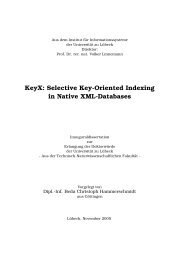Gesture-Based Interaction with Time-of-Flight Cameras
Gesture-Based Interaction with Time-of-Flight Cameras
Gesture-Based Interaction with Time-of-Flight Cameras
Create successful ePaper yourself
Turn your PDF publications into a flip-book with our unique Google optimized e-Paper software.
4.1 Introduction<br />
4<br />
Shading Constraint Improves TOF<br />
Measurements<br />
In this chapter, we present a technique for improving the accuracy <strong>of</strong> the TOF cam-<br />
era’s range measurements, based on the insight that the range and intensity mea-<br />
surements are not independent, but are linked by the shading constraint: Assuming<br />
that the reflectance properties <strong>of</strong> the object surface are known, we can deduce the in-<br />
tensity image that should be observed. In practice, a general reflectance model (such<br />
as Lambertian reflectance) will provide an acceptable approximation to the proper-<br />
ties <strong>of</strong> a wide range <strong>of</strong> objects.<br />
In theory, the shading constraint can be used to reconstruct the range map from<br />
an intensity image alone; this idea has been exploited in a wide range <strong>of</strong> shape from<br />
shading (SfS) algorithms (see (Zhang et al., 1999; Durou et al., 2008) for surveys).<br />
A principal limitation <strong>of</strong> these algorithms, however, is that they cannot determine<br />
whether intensity changes are caused by the object’s shape or by changes in the ob-<br />
ject’s reflectivity (or albedo). Because <strong>of</strong> this, the object is usually assumed to have<br />
constant albedo; this limits the applicability <strong>of</strong> SfS methods.<br />
The range map measured by the TOF camera places a strong additional con-<br />
straint on the shape <strong>of</strong> the object, allowing ambiguities that may exist in the pure SfS<br />
setting (Durou and Piau, 2000) to be resolved and enabling the albedo <strong>of</strong> the surface<br />
to be estimated, both globally for an entire object as well as locally for objects where<br />
albedo varies across the surface.<br />
This chapter describes results obtained in collaboration <strong>with</strong> Martin Böhme, who formulated the<br />
probabilistic model <strong>of</strong> image formation used to enforce the shading constraint. Martin Böhme and I<br />
contributed approximately equally to refining and implementing the method. The work described here<br />
has previously been published in (Böhme et al., 2008b, 2010).<br />
33

















